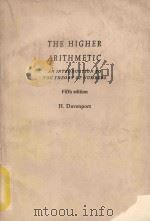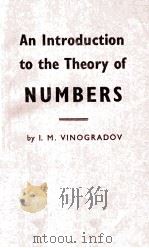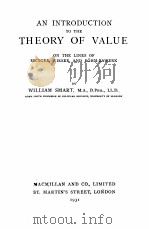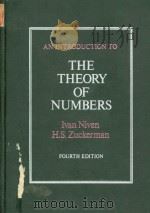《an introduction to the theory of numbers = 数论导引 英文版 第5版 P435》
| 作者 | 编者 |
|---|---|
| 出版 | 未查询到或未知 |
| 参考页数 | |
| 出版时间 | 没有确切时间的资料 目录预览 |
| ISBN号 | 无 — 求助条款 |
| PDF编号 | 820576808(仅供预览,未存储实际文件) |
| 求助格式 | 扫描PDF(若分多册发行,每次仅能受理1册) |

Ⅰ.THE SERIES OF PRIMES (1)1
1.1.Divisibility of integers1
1.2.Prime numbers1
1.3.Statement of the fundamental theorem of arithmetic3
1.4.The sequence of primes3
1.5.Some questions concerning primes5
1.6.Some notations7
1.7.The logarithmic function8
1.8.Statement of the prime number theorem9
Ⅱ.THE SERIES OF PRIMES (2)12
2.1.First proof of Euclid's second theorem12
2.2.Further deductions from Euclid's argument12
2.3.Primes in certain arithmetical progressions13
2.4.Second proof of Euclid's theorem14
2.5.Fermat's and Mersenne's numbers14
2.6.Third proof of Euclid's theorem16
2.7.Further remarks on formulae for primes17
2.8.Unsolved problems concerning primes19
2.9.Moduli of integers19
2.10.Proof of the fundamental theorem of arithmetic21
2.11.Another proof of the fundamental theorem21
Ⅲ.FAREY SERIES AND A THEOREM OF MINKOWSKI23
3.1.The definition and simplest properties of a Farey series23
3.2.The equivalence of the two characteristic properties24
3.3.First proof of Theorems 28 and 2924
3.4.Second proof of the theorems25
3.5.The integral latticc26
3.6.Some simple properties of the fundamental lattice27
3.7.Third proof of Theorems 28 and 2929
3.8.The Farey dissection of the continuum29
3.9.A theorem of Minkowski31
3.10.Proof of Minkowski's theorem32
3.11.Developments of Theorem 3734
Ⅳ.IRRATIONAL NUMBERS38
4.1.Some generalities38
4.2.Numbers known to be irrational38
4.3.The theorem of Pythagoras and its generalizations39
4.4.The use of the fundamental theorem in the proofs of Theorems43-4541
4.5.A historical digression42
4.6.Geometrical proof of the irrationality of √544
4.7.Some more irrational numbers45
Ⅴ.CONGRUENCES AND RESIDUES48
5.1.Highest common divisor and least common multiple48
5.2.Congruences and classes of residues49
5.3.Elementary properties of congruences50
5.4.Linear congruences51
5.5.Euler's function φ(m)52
5.6.Applications of Theorems 59 and 61 to trigonometrical sums54
5.7.A general principle57
5.8.Construction of the regular polygon of 17 sides57
Ⅵ.FERMAT'S THEOREM AND ITS CONSEQUENCES63
6.1.Fermat's theorem63
6.2.Some properties of binomial coefficients63
6.3.A second proof of Theorem 7265
6.4.Proof of Theorem 2266
6.5.Quadratic residues67
6.6.Special cases of Theorem 79: Wilson's theorem68
6.7.Elementary properties of quadratic residues and non-residues69
6.8.The order of a (mod m)71
6.9.The converse of Fermat's theorem71
6.10.Divisibility of 2p-1-1 by p272
6.11.Gauss's lemma and the quadratic character of 273
6.12.The law of reciprocity76
6.13.Proof of the law of reciprocity77
6.14.Tests for primality78
6.15.Factors of Mersenne numbers; a theorem of Euler80
Ⅶ.GENERAL PROPERTIES OF CONGRUENCES82
7.1.Roots of congruences82
7.2.Integral polynomials and identical congruences82
7.3.Divisibility of polynomials (modm)83
7.4.Roots of congruences to a prime modulus84
7.5.Some applications of the general theorems85
7.6.Lagrange's proof of Fermat's and Wilson's theorems87
7.7.The residue of {1/2(p- 1)}!87
7.8.A theorem of Wolstenholme88
7.9.The theorem of von Staudt90
7.10.Proof of von Staudt's theorem91
Ⅷ.CONGRUENCES TO COMPOSITE MODULI94
8.1.Linear congruences94
8.2.Congruences of higher degree95
8.3.Congruences to a prime-power modulus96
8.4.Examples97
8.5.Bauer's identical congruence98
8.6.Bauer's congruence: the case p = 2100
8.7.A theorem of Leudesdorf100
8.8.Further consequences of Bauer's theorem102
8.9.The residues of 2p-1 and (p-1)! to modulus p2104
Ⅸ.THE REPRESENTATION OF NUMBERS BY DECIMALS107
9.1.The decimal associated with a given number107
9.2.Terminating and recurring decimals109
9.3.Representation of numbers in other scales111
9.4.Irrationals defined by decimals112
9.5.Tests for divisibility114
9.6.Decimals with the maximum period114
9.7.Bachet's problem of the weights115
9.8.The game of Nim117
9.9.Integers with missing digits120
9.10.Sets of measure zero121
9.11.Decimals with missing digits122
9.12.Normal numbers124
9.13.Proof that almost all numbers are normal125
Ⅹ.CONTINUED FRACTIONS129
10.1.Finite continued fractions129
10.2.Convergents to a continued fraction130
10.3.Continued fractions with positive quotients131
10.4.Simple continued fractions132
10.5.The representation of an irreducible rational fraction by a simple continued fraction133
10.6.The continued fraction algorithm and Euclid's algorithm134
10.7.The difference between the fraction and its convergents136
10.8.Infinite simple continued fractions138
10.9.The representation of an irrational number by an infinite con-tinued fraction139
10.10.A lemma140
10.11.Equivalent numbers141
10.12.Periodic continued fractions143
10.13.Some special quadratic surds146
10.14.The series of Fibonacci and Lucas148
10.15.Approximation by convergents151
Ⅺ.APPROXIMATION OF IRRATIONALS BY RATIONALS154
11.1.Statement of the problem154
11.2.Generalities concerning the problem155
11.3.An argument of Dirichlet156
11.4.Orders of approximation158
11.5.Algebraic and transcendental numbers159
11.6.The existence of transcendental numbers160
11.7.Liouville's theorem and the construction of transcendentalnumbers161
11.8.The measure of the closest approximations to an arbitrary irrational163
11.9.Another theorem concerning the convergents to a continued fraction164
11.10.Continued fractions with bounded quotients165
11.11.Further theorems concerning approximation168
11.12.Simultaneous approximation169
11.13.The transcendence of e170
11.14.The transcendence of π173
Ⅻ.THE FUNDAMENTAL THEOREM OF ARITHMETIC IN k(l),k(i), AND k(p)178
12.1.Algebraic numbers and integers178
12.2.The rational integers, the Gaussian integers, and the integers ofk(p)178
12.3.Euclid's algorithm179
12.4.Application of Euclid's algorithm to the fundamental theorem in k(1)180
12.5.Historical remarks on Euclid's algorithm and the fundamental theorem181
12.6.Properties of the Gaussian integers182
12.7.Primes in k(i)183
12.8.The fundamental theorem of arithmetic in k(i)185
12.9.The integers of k(p)187
ⅩⅢ.SOME DIOPHANTINE EQUATIONS190
13.1.Fermat's last theorem190
13.2.The equation x2+y2 = z2190
13.3.The equation x4+y4 = z4191
13.4.The equation x3+y3 = z3192
13.5.The equation x3+y3 = 3z3196
13.6.The expression of a rational as a sum of rational cubes197
13.7.The equation x3+y3+z3l3199
ⅩⅣ.QUADRATIC FIELDS (1)204
14.1.Algebraic fields204
14.2.Algebraic numbers and integers; primitive polynomials205
14.3.The general quadratic field k(√m)206
14.4.Unities and primes208
14.5.The unities of k(√2)209
14.6.Fields in which the fundamental theorem is false211
14.7.Complex Euclidean fields212
14.8.Real Euclidean fields213
14.9.Real Euclidean fields (continued)215
ⅩⅤ.QUADRATIC FIELDS218
15.1.The primes of k(i)218
15.2.Fermat's theorem in k(i)219
15.3.The primes of k(p)220
15.4.The primes of k(√2) and k(√5)221
15.5.Lucas's test for the primality of the Mersenne number M4n+3223
15.6.General remarks on the arithmetic of quadratic fields225
15.7.Ideals in a quadratic field227
15.8.Other fields230
ⅩⅥ.THE ARITHMETICAL FUNCTIONS φ(n), μ(n), d(n), σ(n), r(n)233
16.1.The function φ(n)233
16.2.A further proof of Theorem 63234
16.3.The Mobius function234
16.4.The Mobius inversion formula236
16.5.Further inversion formulae237
16.6.Evaluation of Ramanujan's sum237
16.7.The functions d(n) and σk(n)239
16.8.Perfect numbers239
16.9.The function r(n)241
16.10.Proof of the formula for r(n)242
ⅩⅦ.GENERATING FUNCTIONS OF ARITHMETICAL FUNCTIONS244
17.1The generation of arithmetical functions by means of Dirichlet series244
17.2.The zeta function245
17.3.The behaviour of ξ(s) when s→1246
17.4.Multiplication of Dirichlet series248
17.6.The generating functions of some special arithmetical functions250
17.6.The analytical interpretation of the Mobius formula251
17.7.The function A(n)253
17.8.Further examples of generating functions254
17.9.The generating function of r(n)256
17.10.Generating functions of other types257
ⅩⅧ.THE ORDER OF MAGNITUDE OF ARITHMETICAL FUNCTIONS260
18.1.The order of d(n)260
18.2.The average order of d(n)263
18.3.The order of σ(n)266
18.4.The order of φ(n)267
18.5.The average order of φ(n)268
18.6.The number of squarefree numbers269
18.7.The order of r(n)270
ⅩⅨ.PARTITIONS273
19.1.The general problem of additive arithmetic273
19.2.Partitions of numbers273
19.3.The generating function of p(n)274
19.4.Other generating functions276
19.5.Two theorems of Euler277
19.6.Further algebraical identities280
19.7.Another formula for F(x)280
19.8.A theorem of Jacobi282
19.9.Special cases of Jacobi's identity283
19.10.Applications of Theorem 353285
19.11.Elementary proof of Theorem 358286
19.12.Congruence properties of p(n)287
19.13.The Rogers-Ramanujan identities290
19.14.Proof of Theorems 362 and 363292
19.15.Ramanujan's continued fraction294
ⅩⅩ.THE REPRESENTATION OF A NUMBER BY TWO OR FOUR SQUARES298
20.1.Waring's problem: the numbers g(k) and G(k)298
20.2.Squares299
20.3.Second proof of Theorem 366299
20.4.Third and fourth proofs of Theorem 366300
20.5.The four-square theorem302
20.6.Quaternions303
20.7.Preliminary theorems about integral quaternions306
20.8.The highest common right-hand divisor of two quaternions307
20.9.Prime quaternions and the proof of Theorem 370309
20.10.The values of g(2) and G(2)310
20.11.Lemmas for the third proof of Theorem 369311
20.12.Third proof of Theorem 369: the number of representations312
20.13.Representations by a larger number of squares314
ⅩⅪ.REPRESENTATION BY CUBES AND HIGHER POWERS317
21.1.Biquadrates317
21.2.Cubes: the existence of G(3) and g(3)318
21.3.Abound for g(3)319
21.4.Higher powers320
21.5.A lower bound for g(k)321
21.6.Lower bounds for G(k)322
21.7.Sums affected with signs: the number v(k)325
21.8.Upper bounds for v(k)326
21.9.The problem of Prouhet and Tarry: the number P(k, j)328
21.10.Evaluation of P(k, j) for particular k and j329
21.11.Further problems of Diophantine analysis332
ⅩⅫ.THE SERIES OF PRIMES (3)340
22.1.The functions ?(x) and ?(x)340
22.2.Proof that ?(x) and ?(x) are of order x341
22.3.Bertrand's postulate and a ‘formula' for primes343
22.4.Proof of Theorems 7 and 9345
22.5.Two formal transformations346
22.6.An important sum347
22.7.The sum ∑ p-1 and the product П(1—p-1)349
22.8.Mertens's theorem351
22.9.Proof of Theorems 323 and 328353
22.10.The number of prime factors of n354
22.11.The normal order of ω(n) and Ω(n)356
22.12.A note on round numbers358
22.13.The normal order of d(n)359
22.14.Selberg's theorem359
22.15.The functions R(x) and V(ξ)362
22.16.Completion of the proof of Theorems 434, 6 and 8365
22.17.Proof of Theorem 335367
22.18.Products of k prime factors368
22.19.Primes in an interval371
22.20.A conjecture about the distribution of prime pairs p, p+2371
ⅩⅩⅢ.KRONECKER'S THEOREM375
23.1.Kronecker's theorem in one dimension375
23.2.Proofs of the one-dimensional theorem376
23.3.The problem of the reflected ray378
23.4.Statement of the general theorem381
23.5.The two forms of the theorem382
23.6.An illustration388384
23.7.Lettenmeyer's proof of the theorem390387
23.8.Estermann's proof of the theorem386
23.9.Bohr's proof of the theorem388
23.10.Uniform distribution390
ⅩⅩⅣ.GEOMETRY OF NUMBERS394
24.1.Introduction and restatement of the fundamental theorem394
24.2.Simple applications395
24.3.Arithmetical proof of Theorem 448397
24.4.Best possible inequalities399
24.5.The best possible inequality for ξ 2+η2400
24.6.The best possible inequality for |ξη|401
24.7.A theorem concerning non-homogeneous forms402
24.8.Arithmetical proof of Theorem 455405
24.9.Tchebotaref's theorem405
24.10.A converse of Minkowski's Theorem 446407
APPENDIX414
1.Another formula for pn414
2.A generalization of Theorem 22414
3.Unsolved problems concerning primes415
A LIST OF BOOKS417
INDEX OF SPECIAL SYMBOLS AND WORDS420
INDEX OF NAMES423
《an introduction to the theory of numbers = 数论导引 英文版 第5版 P435》由于是年代较久的资料都绝版了,几乎不可能购买到实物。如果大家为了学习确实需要,可向博主求助其电子版PDF文件。对合法合规的求助,我会当即受理并将下载地址发送给你。
高度相关资料
-

- AN INTRODUCTION TO THE THEORY OF COMPUTATION
- 1989 COMPUTER SCIENCE PRESS
-

- An introduction to the theory of numbers Fifth Edition
- 1979 Oxford University Press
-

- The higher arithmetic an introduction to the theory of numbers Fifth Edition
- 1982 Cambridge University Press
-

- AN INTRODUCTION TO THE THEORY OF SEISMILOGY
- 1963 CAMBRIDGE UNIV PR
-

- An Introduction To The Theory of Numbers
- 1955 Pergmon Press
-

- AN INTRODUCTION TO THE THEORY OF RELATIVITY
- 1964 BUTTERWORTHS
-

- AN INTRODUCTION TO THE THEORY OF NUMBERS THIRD EDITION
- 1954 OXFORD AT THE CLARENDON PRESS
-

- AN INTRODUCTION TO THE THEORY OF NUMBERS THIRD EDITION
- 1958 OXFORD AT THE CLARENDON PRESS
-

- INTRODUCTION TO THE THEORY OF NUMBERS
- 1929 THE UNIVERSITY OF CHICAGO PRESS
-

- AN INTRODUCTION TO THE THEORY OF VALUE
- 1931 MACMILLAN AND CO.
-

- AN INTRODUCTION TO THE THEORY OF ELASTICITY
- 1980 LONGMAN
提示:百度云已更名为百度网盘(百度盘),天翼云盘、微盘下载地址……暂未提供。➥ PDF文字可复制化或转WORD



